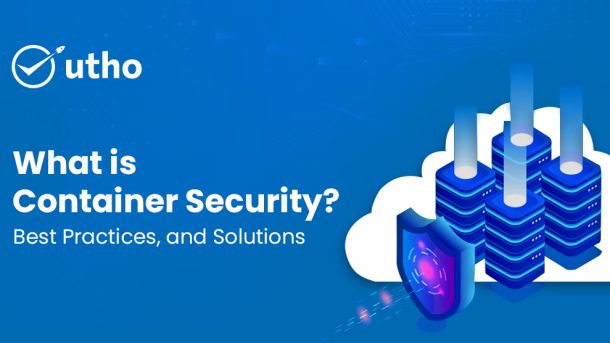As container adoption continues to grow, the need for sustainable container security solutions is more critical than ever. According to trusted sources, 90 percent of global organizations will use containerized applications in production by 2026, up from 40 percent in 2021.
The use of containers is growing. So are security threats to container services. These services include Docker, Kubernetes, and Amazon Web Services. As companies adopt containers or get more of them, the risk of these threats increases.
If you're new to containers, you might be wondering: What is container security? How does it work? This blog aims to give an overview of the methods that security services use. They use them to protect containers.
Understanding Container Security
Container security involves practices, strategies, and tools aimed at safeguarding containerized applications from vulnerabilities, malware, and unauthorized access.
Containers are lightweight units that bundle applications with their dependencies, ensuring consistent deployment across various environments for enhanced agility and scalability. Despite their benefits in application isolation, containers share the host system's kernel, which introduces unique security considerations. These concerns must be addressed throughout the container's lifecycle, from development and deployment to ongoing operations.
Effective container security measures focus on several key areas. Firstly, to ensure container images are safe and reliable, they undergo vulnerability scans and are created using trusted sources. Securing orchestration systems such as Kubernetes, which manage container deployment and scaling, is also crucial.
Furthermore, implementing robust runtime protection is essential to monitor and defend against malicious activities. Network security measures and effective secrets management are vital to protect communication between containers and handle sensitive data securely.
As containers continue to play a pivotal role in modern software delivery, adopting comprehensive container security practices becomes imperative. This approach ensures organizations can safeguard their applications and infrastructure against evolving cyber threats effectively.
How Container Security Works
Host System Security
Container security starts with securing the host system where the containers run. This includes patching vulnerabilities, hardening the operating system and continuously monitoring threats. A secure host provides a strong base for running containers. It ensures their security and reliability.
Runtime protection
At runtime, containers are actively monitored for abnormal or malicious behavior. Containers have a short lifespan. They can be created or terminated often. So, real-time protection is vital. We flag any suspicious behavior. This allows an immediate response. It helps us reduce potential threats.
Image inspection
Security experts examine container images minutely for potential vulnerabilities prior to deployment. This proactive step ensures that only safe images are used to create containers. Regular updates and patches make security better. They do this by fixing new vulnerabilities as they are found.
Network segmentation
In multi-container environments, network segmentation controls and limits communication between containers. This prevents threats from spreading laterally across the network. By isolating containers or groups of containers, network segmentation contains breaches. It secures the container ecosystem as a whole.
Why Container Security Matters
Rapid Container Lifecycle
You can start, change, or stop containers in seconds. This lets you deploy them quickly in many places. This flexibility is useful. But, it makes managing, monitoring, and securing each container hard. Without oversight, it will be hard to ensure the safety and integrity of this ecosystem. The ecosystem is dynamic.
Shared Resource Vulnerability
Containers share resources with the host and neighboring containers, creating potential vulnerabilities. If one container becomes compromised, it can compromise shared resources and neighboring containers.
Complex microservice architecture
A microservice architecture with containers improves scalability and manageability but increases complexity. Splitting applications into smaller services creates more dependencies and paths. Each one can be vulnerable. This connection makes monitoring hard. It also increases the challenge of protecting against threats and data breaches.
Common Challenges in Securing Application Containers
Securing Application Containers presents several key challenges that organizations must address:
Distributed and dynamic environments
Containers often span multiple hosts and clouds. This expands the attack surface and makes it hard for security management. Architectures shift, practices weaken, and security lapses emerge as a result.
Short tank life
tanks are short-lived, start and stop frequently. This transient nature makes traditional security monitoring and incident response difficult. Detecting breaches fast and responding in real-time is critical. Evidence can be lost if a container crashes.
Dangerous or harmful container images
Using container images, especially from public archives, poses security risks. All images fail a strict security check. They lack security holes or harmful code. Ensuring image integrity and security before deployment is essential to mitigating these risks.
Risk from Open Source Components
Container apps rely on open source. They can create security holes if not managed. Regularly scan images for known vulnerabilities. Update components and watch for new risks. These steps are essential to protecting container environments.
Compliance
You need to comply with regulations like GDPR, HIPAA, or PCI DSS in containers. This requires adapting security policies. These policies aim to support traditional deployments. Ensuring data protection, privacy, and audit trails is hard. This is true without specific container guidelines. Meeting regulatory standards requires them.
Meeting these challenges requires constant security measures for containers. They must include real-time monitoring, image scanning, and proactive vulnerability management. This approach makes sure that containerized apps stay secure. It works in changing threat and regulatory environments.
Simplified Container Security Components
Container security includes securing the following critical areas:
Registry Security
Container images are stored in registries prior to deployment. The protected registry looks for security holes in images. It ensures their integrity with digital signatures and limits access to authorized users. Regular updates ensure that applications are protected against known threats.
Runtime Protection
Protecting containers at runtime includes monitoring for suspicious activity. It also includes access control and container isolation to stop tampering. Active-time protection tools detect unauthorized access and network attacks, reducing risks during use.
Orchestration security
Platforms like Kubernetes manage the container lifecycle centrally. Security measures include role-based permissions, data encryption and timely updates to reduce vulnerabilities. Orchestrated security ensures secure deployment and management of containerized applications.
Network security
Controlling network traffic inside and outside containers is critical. Defined policies govern communication, encrypt traffic with TLS and continuously monitor network activity. This prevents unauthorized access and data breaches through network exploitation.
Storage protection
Storage protection includes protecting storage volumes, ensuring data integrity, and encrypting sensitive data. Regular checks and strong backup strategies protect against unauthorized access and data loss.
Environmental Security
Securing the hosting infrastructure includes protecting hosting systems. This is done with firewalls, strict access control, and secure communication. Regular security assessments and following best practices help protect container environments. They do this by guarding them against potential threats.
By managing these parts well, organizations improve container security. They also ensure that cyber threats can't harm applications and data as they evolve.
Container Security Solutions
Container Monitoring Solutions
These tools provide real-time visibility into container performance, health, and security. They monitor metrics, logs, and events. They use them to find anomalies and threats, like odd network connections or resource use.
Container scanners
The scanners check images for known bugs and issues. They do this before and after deployment. The reports help developers and security teams. They have lots of details. They help to reduce risks early in the CI/CD process.
Container network tools
Essential for managing container communication on and off networks. These tools monitor network segmentation. They watch ingress and egress rules. They ensure that containers operate within strict network parameters. They integrate with orchestrators like Kubernetes to automate network policies.
Cloud Native Security Solutions
These end-to-end platforms cover the entire application lifecycle. Cloud Native Application Protection Platforms (CNAPP) integrate security with development, runtime, and monitoring. CWPPs focus on securing workloads. They do so across environments, including containers. They use features like vulnerability management and continuous protection.
These solutions work together. They make container security stronger. They provide monitoring, vulnerability management, and network isolation. They protect apps in dynamic computing.
Best Practices for Container Security Made Simple
Use the Least Privilege
Limit container permissions to only those necessary for their operation. For example, a container read from the database should not have write access. This reduces the potential damage if the container is damaged.
Use thin ephemeral containers
Deploy lightweight containers that perform a single function and are easily replaceable. Thin containers reduce the parts that attackers can target. Ephemerals reduce the attack window.
Use minimal images
choose minimal repositories that contain essential binaries and libraries. This reduces attack vectors and improves performance by reducing size and startup time. Update these images regularly for security patches.
Use immutable deployments
Deploy new containers instead of modifying existing containers to avoid unauthorized changes. This ensures consistency, simplifies recovery and improves reliability without changing the configuration.
Use TLS for service communication
Encrypt data transferred between containers and services using TLS (Transport Layer Security). It prevents eavesdropping and spoofing. It secures the exchange of sensitive data from threats like random attacks.
Use the Open Policy Agent (OPA)
OPA enforces consistent policies across the whole container stack. It controls deployment, access, and management. OPA integrates with Kubernetes. It supports strict security policies. They ensure compliance and control for containers.
Common Mistakes in Container Security to Avoid
Ignoring Basic Safety Practices:
Tanks may be modern technology, but basic safety hygiene is still critical. It is important to keep systems updated. This includes operating systems and container runtimes. This helps prevent attackers from exploiting security holes.
Failure to configure and validate environments:
Containers and orchestration tools have strong security. But, they need proper configuration to work. The default settings are often not secure enough. Adapt settings to your environment. Also, limit container permissions and capabilities to minimize risks. For example, risks like privilege escalation attacks.
Lack of monitoring, logging and testing:
Using containers in production without enough monitoring, logging, and testing can create bottlenecks. They can harm the health and security of your application. This is especially true for distributed systems. They span multiple cloud environments and on-premises infrastructure. Good monitoring and logging are key. They help identify and mitigate vulnerabilities and operational issues before they escalate.
Ignoring CI/CD pipeline security:
Container security shouldn't stop at deployment. Integrating security across the CI/CD pipeline – from development to production – is essential. A "left" approach puts security first in the software supply chain. It ensures that security tools and practices are used at all stages. This proactive approach minimizes security risks and provides strong protection for containerized applications.
Container Security Market: Driving Factors
The market for container security is growing a lot. This is due to the popularity of microservices and digital transformation. Companies are adopting containers more. They use them to modernize IT and to virtualize data and workloads. This change improves cloud security. It moves from a traditional, container-based architecture to a more flexible one.
Businesses worldwide are seeing the benefits of container security. It brings faster responses, more revenue, and better decisions. This technology enables automation and customer-centric services, increasing customer acquisition and retention.
Also, containers help apps talk and work on open-source platforms. It improves portability, traceability, and flexibility, ensuring minimal data loss in emergency situations. These factors are adding to the swift growth of the container security market. This growth is crucial for the future of the global industry.
Unlock the Benefits of Secure Containers with Utho
Containers are essential for modern app development but can pose security risks. At Utho, we protect your business against vulnerabilities and minimize attack surfaces.
Benefits:
- Enhanced Security: Secure your containers and deploy applications safely.
- Cost Savings: Achieve savings of up to 60%.
- Scalability: Enjoy instant scaling to meet your needs.
- Transparent Pricing: Benefit from clear and predictable pricing.
- Top Performance: Experience the fastest and most reliable service.
- Seamless Integration: Easily integrate with your existing systems.
- Dedicated Migration: Receive support for smooth migration.
Book a demo today to see how we can support your cloud journey!



